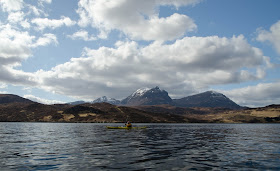The next few posts are a catch-up of a sea kayak trip to the northwest of Scotland around Easter. A slim window of lighter winds was forecast to follow a period of strong northerlies which we hoped to exploit. We expected cold conditions and planed to use bothies though we were equipped to camp.
Our plans were very flexible with no defined goals other than enjoying our first overnight sea kayak trip of the year.
Leaving home at dawn, it was clear that we would probably get the cold conditions we expected! The temperature was minus 5 Celsius and the road from home a little slippy. I'd arranged to meet Allan and Lorna at Inverness at 0900, so that we could get into position and be on the water further north by lunchtime.
We arrived at Kylesku after a drive which (visibility permitting) is one of the most scenic anywhere; north of Ullapool the road heads into Assynt, a truly ancient landscape. You can put in at the former ferry slip adjacent to the hotel, but parking can be difficult there. We wheeled our boats on trolleys down a rough track near the fishing jetty to launch off a stony beach and parked the vehicles in a layby on the road.
The weather was, if anything, better than forecast and there was even some warmth in the sunshine. Our plan was to head east into the twin lochs of Glencoul and Glendhu, each of which has a bothy in their upper reaches. This being Easter, we expected others to have the same idea, hence we were fully equipped and prepared to camp elsewhere.
Rounding the dividing headland of Aird da Loch (appropriately "height of the two lochs") an impressive view opens up along Loch Glencoul to the rugged hills surrounding the head of the loch. The most prominent of these is the Stack of Glencoul, a 494m/1621ft boss of steep rock.
At our right shoulder was a superb view to Quinag, one of my favourite hills - it's been way too long since I climbed it.
Paddling up Loch Glencoul is like moving along a geological text book writ large. The pinkish rock outcropping in a tilted plane above Allan in this image is Cambrian Quartzite; at the top right of the image you can see the start of another type of rock overlying the quartzite.
The astonishing thing is that the overlying rock is much older than the Cambrian rock below. This is the Glencoul Thrust zone, a part of the complex Moine Thrust zone. A good explanation with photographs to illustrate the stacked-up nature of the rock is provided by Oxford University as notes for its students fieldwork (thanks to Allan for pointing me to this resource).
The head of Loch Glencoul is a wild and majestic place, surrounded by rugged hills. There's no easy access on foot to this spot, the natural way to arrive is by water.
We headed for the broad beach on the north side of the loch, just below the house of Glencoul. The building on the shore is a boathouse and storage shed, the house and adjacent bothy is just above the beach to the right. We were arriving near low water one day before Springs - the water goes back for some 100 metres as the beach is fairly flat.
Nobody was about when we landed, but three open canoes drawn up near the bothy indicated that folk were in residence. We thought we'd be able to camp and share the bothy during the evening, but......
...on opening the bothy door it was clear that it was absolutely rammed with kit and gear. A single party of eight had taken every available inch of space. Even if we'd camped there wouldn't have been space for us to cook or share the evening in the bothy.
This was a little disappointing, the bothy code is pretty straightforward concerning group size and duration of stay - and this group intended to stay a while. They were a "Song of the Paddle" members group and left the bothy book right below a notice asking groups of six or more to neither use the bothy or to camp nearby...... It was undoubtedly a fabulous adventure for the kids, just too many folk at one time for a wee bothy.
Above the head of the bay, a prominent white marble cross commemorates the Eliot brothers, two lads enlisted in highland regiments and both killed in the slaughter of the western front in 1917 and 1918.
Their bodies aren't here, but the spot chosen for their memorial has a view which has few rivals.
The afternoon sunshine was warm and there was almost no breeze, quite a difference in temperature from the "cool" early morning back in Aberdeenshire! We ate a late luncheon with our backs to a warm drystone wall the bothy and discussed plans. Adding our three to the eight folk here would detract from the wild feel of this spot; and we decided to spend the night elsewhere. But before heading back down Loch Glencoul there was somewhere else we wanted to explore...











Unlucky to get another group in residence in such a remote spot during cold paddling conditions that would put most kayakers off I'd imagine. Backpacked between both bothies in knee deep snow over a decade ago and it did feel remote then as you had to shovel a parking place out to find a layby before we even left the road. A lovely area.
ReplyDeleteLuck of the draw Bob, the group in residence included small kids, and they will have had a fantastic adventure. We could have camped, but as you'll know Glencoul is one of the smaller bothies and there just wouldn't have been space to share the place in the evening.
ReplyDeleteHardcore stuff traversing between these two in deep snow - it's a rugged enough area in good conditions!
:o)